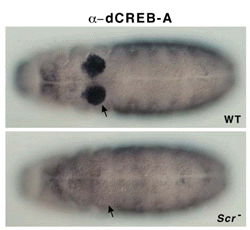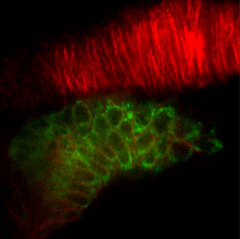- Pascini TV, Jeong YJ, Huang W, Pala ZR, Sá JM, Wells MB, Kizito C, Sweeney B, Alves E Silva TL, Andrew DJ, Jacobs-Lorena M, Vega-Rodríguez J. Nat Commun. 2022 May 26;13(1):2949. doi: 10.1038/s41467-022-30606-y.PMID: 35618711
- Loganathan R, Levings DC, Kim JH, Wells MB, Chiu H, Wu Y, Slattery M, Andrew DJ. J Cell Biol. 2022 Apr 4;221(4):e202110073. doi: 10.1083/jcb.202110073. Epub 2022 Feb 23.PMID: 35195669
- Taracena M, Hunt C, Pennington P, Andrew D, Jacobs-Lorena M, Dotson E, Wells M. J Vis Exp. 2022 Mar 1;(181). doi: 10.3791/63266.PMID: 35311819
- Loganathan R, Kim JH, Wells MB, Andrew DJ. Curr Top Dev Biol. 2021;143:1-36. doi: 10.1016/bs.ctdb.2020.09.005. Epub 2020 Nov 19.PMID: 33820619
- Chiu MZ, Lannon S, Luchetti M, Wells MB, Andrew DJ. J Vis Exp. 2021 Sep 30;(175). doi: 10.3791/62989.PMID: 34661579
- Chung S, Le TP, Vishwakarma V, Cheng YL, Andrew DJ. Genetics. 2021 Oct 2;219(2):iyab100. doi: 10.1093/genetics/iyab100.PMID: 34173831
- Kim JH, Hanlon CD, Vohra S, Devreotes PN and Andrew DJ. 2021. Hedgehog signaling and Tre1 regulate actin dynamics through PI(4,5)P2 to direct migration of Drosophila embryonic germ cells. Cell Rep. 2021 Mar 2;34(9):108799. doi: 10.1016/j.celrep.2021.108799. PMC8023404.
- Johnson, D.J. Wells, M.B., Fox, R.M., Lee, J.S., Loganathan, R., Levings, D, Bastien, A., Slattery, M. and Andrew, D.J. (2020) CrebA increases secretory capacity through direct transcriptional regulation of the secretory machinery, a subset of secretory cargo, and other key regulators. Traffic 21: 560-577.
- Loganathan, R., Kim, J.H., Wells, M.B., and Andrew, D.J. (2020) Secrets of secretion – How studies of the Drosophila salivary gland have informed our understanding of the cellular networks underlying secretory organ form and function. Current Topics in Developmental Biology: Cellular Networks in Development. https://doi.org/10.1016/bs.ctdb.2020.09.005
- Chiu M, Trigg B, Taracena M, and Wells MB. (2020). Diverse cellular morphologies during lumen maturation in Anopheles gambiae larval salivary glands. Insect Mol Biol. doi: 10.1111/imb.12689. (Andrew Lab publication)
Johnson, D.M. and Andrew, D.J. (2019) Role of tbc1 in Drosophila embryonic salivary glands. BMC Cell and Molec. Biol 20:19
Wells, M.B. and Andrew, D.J. (2019). Anopheles Salivary Gland Architecture Shapes Plasmodium Sporozoite Availability for Transmission. mBio. 2019 Aug 6;10(4):e01238-19. doi: 10.1128/mBio.01238-19.PMID: 31387905.
Andrew, D.J., Chen, E.H., Manoli, D.S., Ryner, L.C. and Arbeitman, M.N. (2019) Sex and the single fly: A perspective on the career of Bruce S. Baker. Genetics 212(2) 365-376
Manning, L., Sheth, J., Bridges, S., Saadin, A., Odinammadu, K., Andrew, D., Spencer, S., Montell, D. and Starz-Gaiano, M. (2017) A hormonal cue promotes timely follicle cell migration by modulating transcription profiles. Mech. Dev. 148: 56-68.
Wells MB, Villamor J, and Andrew DJ. Salivary gland maturation and duct formation in the African malaria mosquito Anopheles gambiae. 2017. Scientific Reports 7:601. DOI: 10.1038/s41598-017-00672-0.
Chung S, Kim S, and Andrew DJ. 2017. Uncoupling apical constriction from tissue invagination. Elife Mar6;6. pii: e22235. doi: 10.7554/eLife.22235. PMCID: PMC5338918
Hanlon CD, Andrew DJ. Drosophila FoxL1 non-autonomously coordinates organ placement during embryonic development. 2016. Dev Biol. 2016 Nov 15;419(2):273-284. doi: 10.1016/j.ydbio.2016.09.007. Epub 2016 Sep 13.
Loganathan R, Lee JS, Wells MB, Grevengood E, Slattery M, Andrew DJ. Ribbon regulates morphogenesis of the Drosophila embryonic salivary gland through transcriptional activation and repression. Dev Biol. 2016 Jan 1;409(1):234-50
Wells, M.B. and Andrew, D.J. (2015) Salivary gland cellular architecture in the Asian malaria vector mosquito Anopheles stephensi. Parasites and Vectors. 8:617. doi: 10.1186/s13071-015-1229-z
Cheng, Y.L. and Andrew, D.J. (2015) Extracellular Mipp1 activity confers migratory advantage to epithelial cells during collective migration. Cell Reports. Published online November 25, 2015.
Hanlon, C.D. and Andrew, D.J. (2015) Outside-in signaling - a brief review of GPCR signaling with a focus on the Drosophila GPCR family. J Cell Sci 128: 3533-3542. PMID: 26345366.
Fox, R.M. and Andrew, D.J. (2015) Transcriptional regulation of secretory capacity by bZip transcription factors. Front Biol 10: 28-51. PMID: 25821458
Loganathan, R., Cheng, Y.L. and Andrew, D.J. (2015) Development of the Drosophila Respiratory System. In: Organogenetics. Springer. In press.
Andrew, D.J. and Yelon, D. (2015) Developmental mechanisms, patterning and organogenesisis. Curr Opin Genet Dev. Epub 2015 Jun 4.
Chung, S.-Y. and Andrew, D.J. (2014) Cadherin 99C regulates apical expansion and cell rearrangement during epithelial tube elongation. Development 141:1950-1960. PMID: 24718992
Fox, R.M., Vaishnavi, A., Maruyama, R., and Andrew, D.J. (2013) Organ-specific gene expression: the bHLH protein Sage provides tissue-specificity to Drosophila FoxA. Development. 140 (10): 2160-2171. PMID: 23578928.
Barbosa S, Fasanella G, Carreira S, Llarena M, Fox R, Barreca C, Andrew D, O'Hare P. 2013 An orchestrated program regulating secretory pathway genes and cargos by the transmembrane transcription factor CREB-H. Traffic. 2013 Apr;14(4):382-98. doi: 10.1111/tra.12038.
Ismat, A., Cheshire, A. and Andrew, D.J. (2013) The secreted AdamTS-A metalloprotease is required for collective cell migration. Development. 140 (9): 1981-93. doi: 10.1242/dev.087908. Epub 2013 Mar 27. PMID: 23536567.
Maruyama, R., Grevengoed, E., Stempniewicz, P., Andrew, D.J. (2011) Genome-wide analysis reveals a major role in cell fate maintenance and an unexpected role in endoreduplication for the Drosophila FoxA gene fork head. PLoS One 6(6): e20901. PMID: 21698206
Chung, S.-Y., Chavez, C. and Andrew, D.J. (2011) Trachealess (Trh) regulates all tracheal genes during Drosophila embryogenesis. Developmental Biology 360: 160-172. PMID: 21963537
Andrew, DJ and Ewald, AJ, “Morphogenesis of epithelial tubes: Insights into tube formation, elongation, and elaboration”, Developmental Biology, 2010 May 1;341(1):34-55.
Fox, R.M., Hanlon, C.D. and Andrew, D.J. (2010) The CrebA/Creb3-like transcription factors are major and direct regulators of secretory capacity. Journal of Cell Biology 191: 479-492. PMID: 21041443
Chung, S.-Y., Vining, M.S., Bradley, P.L., Chan, C.-C., Wharton, K.A. and Andrew, D.J. (2009) Serrano (Sano) functions with the planar cell polarity genes to control tracheal tube length. PLoS Genetics 5(11): e1000746. PMID: 19956736.
Kerman, B.E., Cheshire, A.M., Myat, M.M., and Andrew, D.J. (2008) Ribbon modulates apical membrane during tube elongation through Crumbs and Moesin. Developmental Biology 320: 278-288. PMID: 18585700
Abrams, E.W., Mihoulides, W.K. and Andrew, D.J. (2006) Fork head and Sage maintain a uniform and patent salivary gland lumen through regulation of two downstream target genes, PH4áSG1 and PH4áSG2. Development 133: 3517-3527. PMID: 16914497.
Abrams, E.W. and Andrew, D.J. (2005) CrebA regulates secretory activity in the salivary gland and epidermis. Development 132: 2743-2758. PMID: 15901661
Bradley, P.L., Myat, M.M., Comeaux, C. and Andrew, D.J. (2003) Posterior migration of the salivary gland requires an intact visceral mesoderm and integrin function. Developmental Biology 257: 249-262. PMID: 12729556
Myat, M.M. and Andrew, D.J. (2002) Epithelial tube morphology is determined by the polarized growth and delivery of apical membrane. Cell 111:879-891. PMID: 12526813.
Bradley, P.L. and Andrew, D.J. (2001) ribbon encodes a BTB-containing transcription factor required for directed cell migration. Development 128: 3001-3015. PMID: 11532922
Myat, M.M. and Andrew, D.J. (2000) Organ shape in the Drosophila salivary gland is controlled by regulated, sequential internalization of the primordia. Development 127: 679-691. PMID: 10648227
Myat, M.M. and Andrew, D.J. (2000) FORK HEAD prevents apoptosis and promotes cell shape change during formation of the Drosophila salivary glands. Development 127: 4217-4226. PMID: 10976053
Isaac, D.D. and Andrew, D.J. (1996) Tubulogenesis in Drosophila: A requirement for the trachealess gene product. Genes and Development 10: 103-117. PMID: 8557189
Bhanot, P., Brink, M., Samos, C.H., Hsieh, J.-C., Wang, Y., Macke, J.P., Andrew, D., Nathans, J., and Nusse, R. (1996) Dfz2, a new member of the frizzled family in Drosophila, functions as a receptor for Wingless. Nature 382: 225-230. PMID: 8717036




